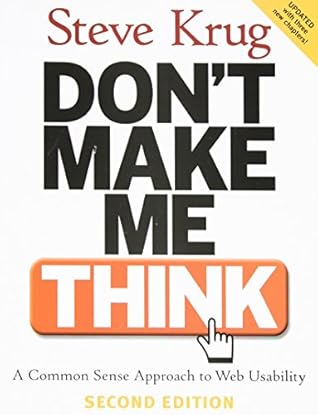More on this book
Community
Kindle Notes & Highlights
Navigation conventions for the Web have emerged quickly, mostly adapted from existing print conventions.
Just having the navigation appear in the same place on every page with a consistent look gives you instant confirmation that you’re still in the same site—which is more important than you might think.
it makes sense not to use the persistent navigation there.
On pages where a form needs to be filled in, the persistent navigation can sometimes be an unnecessary distraction.
we expect to see the Site ID at the top of the page—usually in (or at least near) the upper left corner.
The Sections—sometimes called the primary navigation—are the links to the main sections of the site: the top level of the site’s hierarchy.
add the word “Home” discreetly to the Site ID everywhere but the Home page to let people know that it’s clickable.
every page should have either a search box or a link to a search page.
It’s a simple formula: a box, a button, and the word “Search.”
If there is any possibility of confusion about the scope of the search (what’s being searched: the site, part of the site, or the whole Web?), by all means spell it out.
I think one of the primary reasons for Amazon’s success is the robustness of its search.
I think this is one of the most common problems in Web design (especially in larger sites): failing to give the lower-level navigation the same attention as the top.
It’s vital to have sample pages that show the navigation for all the potential levels of the site before you start arguing about the color scheme for the Home page.
Every page needs a name.
The name needs to be in the right place.
The name needs to be prominent.
The name of the page will match the words I clicked to get there.
(a) they match as closely as possible, and (b) the reason for the difference is obvious.
“You are here”
The most common failing of “You are here” indicators is that they’re too subtle. They need to stand out; if they don’t, they lose their value as visual cues and end up just adding more noise to the page.
Web users are generally in such a hurry that they routinely miss subtle cues.
I don’t think that Breadcrumbs alone are a good navigation scheme.
About.com has the best Breadcrumbs implementation I know of, and it illustrates several “best practices.”
Breadcrumbs seem to work best if they’re at the top of the page, above everything.
When Breadcrumbs are farther down on the page they end up contending with the primary navigation.
Don’t use them instead of a page name.
headings are flush left or centered,
I’ve never seen anyone—no matter how “computer illiterate”—look at a tabbed interface and say, “Hmmm. I wonder what those do?”
because tabs are so visually distinctive, they’re hard to overlook.
we’re very good at detecting (“things in front of other things”).
Amazon was one of the first sites to use tab dividers for navigation, and the first to really get them right.
Color is great as an additional cue, but you should never rely on it as the only cue.
There was a tab selected when you enter the site.
we’ve followed a link from a search engine or from another site, and we’ve never seen this site’s navigation scheme before.
The standard needs to be that these elements pop off the page so clearly that it doesn’t matter whether you’re looking closely or not.
the visual hierarchy matches the logical hierarchy.
“Get rid of half the words on each page, then get rid of half of what’s left.”
See Jakob Nielsen’s October 1997 Alertbox column, “How Users Read on the Web” available at www.useit.com.
pick up a copy of Information Architecture for the World Wide Web by Louis Rosenfeld and Peter Morville (O’Reilly, 2002) and take to heart everything they have to say about search.
Keith Instone has an excellent treatment of the whole subject of Breadcrumbs at http://user-experience.org
Peter Glour’s book Elements of Hyper-media Design, which you can read for free online at www.ickn.org/elements/hyper/hyper.htm
Whatever you do, don’t use tab-shaped graphics if they’re not going to behave like tabs. The Internet Movie Database—owned by Amazon, and in some ways one of the best sites on the Web—makes this mistake.


